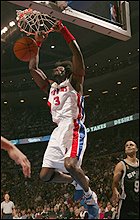
I have a prediction (this may not be a new prediction, so bear with me in my ignorance): in the next five to ten years, organizations will increasingly be forced to put younger employees in positions that demand more responsibility than previous generations before them in the same roles. Put another way, organizations that want to survive in this New Economy must begin placing younger talent in “stretch” roles to ensure a solid foundation for the future.
For me, there are no “if” “ands” or “buts” about this statement. The Baby Boom Generation’s gradual retirement over the next 10 -15 years is inevitable. And so is the fact that at the end of the day, there will be anywhere from 30 to 40 million less workers by that time in the
Something’s gotta give.
This will be part of an ongoing “series” of rants for me, so I’ll gradually speak about all the ramifications of the above statement I just made. For today, I want to address one aspect of how companies view candidates interviewing for open opportunities.
Let’s start at the beginning. The typical company usually opens a job requisition when there is an available position somewhere. Once that job requisition (or “req.” as it’s so often called) is opened, recruiters usually huddle with the hiring managers involved and discuss the details of the position. After this, the green light is given and it’s all systems go. The recruiter begins to scour the corners of the Earth looking for the perfect candidate, while the hiring manager tries to balance their work load with interviewing candidates that pass through the screening process.
In my personal opinion, though, there’s a BIG disconnect in this whole process. It’s at the point where the recruiter and hiring manager huddle together to discuss the “details.” Experience, educational background, communications skills…all of these (and many more) things end up being discussed at some point in the process. That’s not the problem. The problem is the lens through which the recruiter and hiring manager are evaluating these prospective candidates.
You see, recruiters and hiring managers (more often than not) look for someone who “fits” the description they’ve laid out for the position. They have to have 6-10 years of experience…possess an MBA degree from a top ten school…come from a top competitor…and so on and so forth. If candidates don’t possess these minimum qualifications, they’re usually given the boot. Especially if the organization is a reputable one that has a good brand name.
My point? Talent for a particular job doesn’t always necessarily “fit” the description the company has laid out. In fact, I’d argue that in a lot of cases, some of the most talented people for the position wouldn’t even come close to “fitting” the description.
Some examples:
Steve Jobs – The iPod guy. Do you honestly think a sane company would have hired someone as CEO who dropped out of college after one semester? Forget hiring for the CEO spot. Do you think a brand name firm (like Intel) would have taken a chance to offer Jobs a full time role as a regular employee? This is the same guy that went to
Ben Wallace – Some of you might be scratching your heads on this one. Yes, he’s an athlete. A 4 time NBA All-Star to be exact. But it doesn’t change the fact that all organizations, sports or not, tend to filter candidates a certain way. Big Ben graduated from a no-name college. Went undrafted because teams thought he was too small for his position and scouts said he had no offensive game. Guess who’s laughing now?
Andy Stanley – Pastor of
These examples just go to show that sometimes, the best people for your organization won’t “fit” into the mold that you create for them. So the question is: will organizations begin to break the mold and see candidates in a whole new light? Moreover, will recruiters and the HR function as a whole learn to filter candidates so that the good ones don’t fall through the cracks?
As more and more Baby Boomers retire, I have a feeling that more and more organizations will be asking and telling themselves “is he/she ready for this type of role?”…”they don’t have enough experience”…”they don’t have the educational background we like”…etc. etc.
But like I said earlier, something’s gotta give.
No comments:
Post a Comment